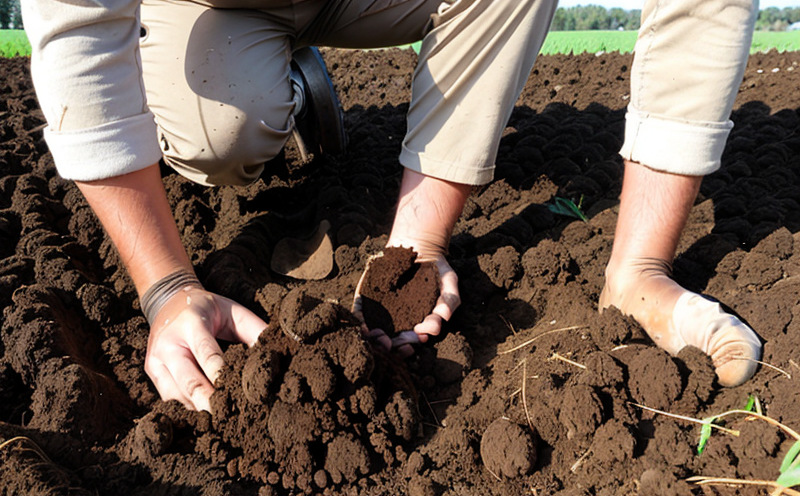Soil Exchangeable Sodium Percentage (ESP) Testing
The Soil Exchangeable Sodium Percentage (ESP) testing is a critical analytical procedure used in soil science to assess the proportion of sodium ions that are available for exchange with cations on the soil colloids. This parameter plays a pivotal role in understanding the salinity levels and potential toxicity of soils, which can significantly impact crop productivity and plant health.
Saline soils, characterized by high concentrations of soluble salts, especially sodium, pose serious challenges to agriculture and forestry. The ESP test is essential for identifying such conditions early on, enabling timely interventions to mitigate adverse effects. By measuring the ESP, agriculturalists can make informed decisions regarding irrigation practices, fertilization strategies, and soil amendments.
The methodology involves extracting soil samples into a solution that allows the exchangeable ions to be separated from the fixed cations in the soil colloids. The resulting solution is then analyzed using various analytical techniques such as atomic absorption spectrophotometry or ion chromatography. The accuracy of these tests is paramount for reliable results, which can guide sustainable agricultural practices and ensure compliance with environmental regulations.
Understanding the ESP value helps determine whether a soil is sodic (containing excessive sodium), which can lead to reduced water infiltration, increased runoff, and decreased root growth. In sodic soils, plants may suffer from poor nutrient uptake, leading to stunted growth or even death. Thus, this test serves as an essential tool in the toolkit of any quality manager or compliance officer looking to ensure soil health and crop sustainability.
The ESP is particularly important for arid and semiarid regions where water management is critical. By quantifying sodium levels, farmers can adjust their irrigation schedules to prevent further salinization. Additionally, this test aids in the evaluation of reclamation projects aimed at restoring degraded soils, ensuring that these efforts are effective and sustainable.
- It helps identify soils prone to sodicity, which is crucial for planning remediation strategies.
- The ESP value informs decisions on whether soil amendments like lime or gypsum are necessary to counteract sodium toxicity.
Why It Matters
Soil salinity, particularly the concentration of exchangeable sodium (Na⁺), can severely affect agricultural productivity and environmental health. High ESP values indicate that a significant portion of soil colloids is occupied by sodium ions, which disrupts the balance between cations necessary for plant nutrition. This imbalance leads to reduced water infiltration, increased runoff, and decreased root growth.
The detrimental effects of high sodium levels extend beyond agricultural concerns; they also impact forestry practices. In forested areas, sodic soils can hinder tree establishment and growth, leading to a decline in biodiversity. The ESP test is therefore indispensable for assessing the soil conditions that support both agriculture and forestry.
Understanding the ESP value allows for the implementation of sustainable agricultural practices such as precision irrigation, which reduces water waste while enhancing crop yields. Moreover, this test aids in evaluating the success of reclamation projects aimed at restoring degraded soils, ensuring that these efforts are effective and sustainable.
The ESP is also crucial for compliance with environmental regulations that mandate the monitoring of soil quality to protect ecosystems and human health. By detecting early signs of salinity issues, farmers can implement corrective measures before significant damage occurs. This proactive approach not only protects crops but also preserves valuable land resources for future generations.
- It prevents water wastage through targeted irrigation practices.
- The test supports sustainable reclamation projects to restore degraded soils.
Why Choose This Test
Choosing Soil Exchangeable Sodium Percentage (ESP) testing for your agricultural and forestry operations offers several advantages. Firstly, it provides a comprehensive assessment of soil salinity levels, which is essential for diagnosing potential issues before they escalate into costly problems. Secondly, this test allows for the precise identification of sodic soils, enabling targeted interventions such as the application of lime or gypsum to mitigate sodium toxicity.
By incorporating ESP testing into your quality management and compliance programs, you can ensure that your soil remains healthy and productive. This proactive approach not only enhances crop yields but also supports sustainable agricultural practices by promoting efficient water use and reducing environmental impact. Additionally, the test results can guide decision-making in reclamation projects, ensuring that these efforts are effective and aligned with sustainability goals.
The ESP test is particularly valuable for regions prone to salinization, such as arid and semiarid areas, where water management plays a critical role in maintaining soil health. By quantifying sodium levels, farmers can adjust their irrigation schedules to prevent further salinization, thus protecting both crops and the environment.
- It offers precise diagnosis of sodic soils for targeted remediation strategies.
- The test supports sustainable reclamation efforts by ensuring effective soil restoration.
Environmental and Sustainability Contributions
The Soil Exchangeable Sodium Percentage (ESP) testing contributes significantly to environmental sustainability by promoting the health of agricultural soils. By identifying and addressing sodic conditions early, this test helps prevent further salinization, which can have detrimental effects on both crops and ecosystems.
Through accurate assessment of soil salinity, farmers and foresters can implement sustainable water management practices that reduce waste while enhancing crop yields. This not only conserves water resources but also minimizes the environmental footprint associated with irrigation systems. Additionally, the test supports reclamation projects by providing data on soil conditions, enabling more effective interventions.
The ESP test aligns with global initiatives aimed at promoting sustainable agriculture and forestry practices. By ensuring that soils remain healthy and productive, this test contributes to food security while minimizing environmental impact. It also supports compliance with international standards such as ISO 14001 for environmental management systems, enhancing overall sustainability efforts.
- It promotes water conservation through targeted irrigation practices.
- The test enhances the effectiveness of reclamation projects by providing accurate soil data.





